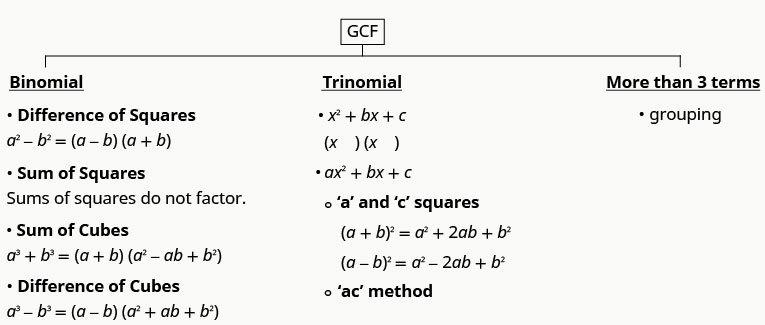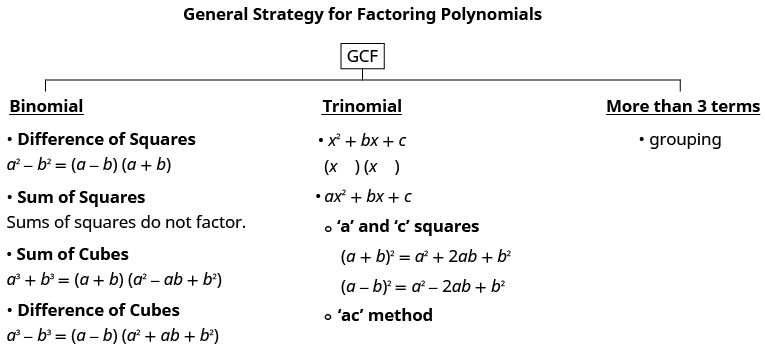14.5: General Strategy for Factoring Polynomials
- Last updated
- Aug 13, 2020
- Save as PDF
- Page ID
- 46377
( \newcommand{\kernel}{\mathrm{null}\,}\)
Learning Objectives
By the end of this section, you will be able to:
- Recognize and use the appropriate method to factor a polynomial completely
Recognize and Use the Appropriate Method to Factor a Polynomial Completely
You have now become acquainted with all the methods of factoring that you will need in this course. The following chart summarizes all the factoring methods we have covered, and outlines a strategy you should use when factoring polynomials.
GENERAL STRATEGY FOR FACTORING POLYNOMIALS

USE A GENERAL STRATEGY FOR FACTORING POLYNOMIALS.
- Is there a greatest common factor?
Factor it out. - Is the polynomial a binomial, trinomial, or are there more than three terms?
If it is a binomial:- Is it a sum?
Of squares? Sums of squares do not factor.
Of cubes? Use the sum of cubes pattern. - Is it a difference?
Of squares? Factor as the product of conjugates.
Of cubes? Use the difference of cubes pattern.
- Is it of the form x2+bx+c? Undo FOIL.
- Is it of the form ax2+bx+c?
If a and c are squares, check if it fits the trinomial square pattern.
Use the trial and error or “ac” method.
- Use the grouping method.
- Is it a sum?
- Check.
Is it factored completely?
Do the factors multiply back to the original polynomial?
Remember, a polynomial is completely factored if, other than monomials, its factors are prime!
Example 14.5.1
Factor completely: 7x3−21x2−70x.
Solution
7x3−21x2−70xIs there a GCF? Yes, 7x.Factor out the GCF.7x(x2−3x−10)In the parentheses, is it a binomial, trinomial,or are there more terms?Trinomial with leading coefficient 1.“Undo” FOIL.7x(x)(x)7x(x+2)(x−5)Is the expression factored completely? Yes.Neither binomial can be factored.Check your answer.Multiply.7x(x+2)(x−5)7x(x2−5x+2x−10)7x(x2−3x−10)7x3−21x2−70x✓
Try It 14.5.1
Factor completely: 8y3+16y2−24y.
- Answer
-
8y(y−1)(y+3)
Try It 14.5.2
Factor completely: 5y3−15y2−270y.
- Answer
-
5y(y−9)(y+6)
Be careful when you are asked to factor a binomial as there are several options!
Example 14.5.2
Factor completely: 24y2−150
Solution
24y2−150Is there a GCF? Yes, 6.Factor out the GCF.6(4y2−25)In the parentheses, is it a binomial, trinomialor are there more than three terms? Binomial.Is it a sum? No.Is it a difference? Of squares or cubes? Yes, squares.6((2y)2−(5)2)Write as a product of conjugates.6(2y−5)(2y+5)Is the expression factored completely?Neither binomial can be factored.Check:Multiply.6(2y−5)(2y+5)6(4y2−25)24y2−150✓
Try It 14.5.3
Factor completely: 16x3−36x.
- Answer
-
4x(2x−3)(2x+3)
Try It 14.5.4
Factor completely: 27y2−48.
- Answer
-
3(3y−4)(3y+4)
The next example can be factored using several methods. Recognizing the trinomial squares pattern will make your work easier.
Example 14.5.3
Factor completely: 4a2−12ab+9b2.
Solution
4a2−12ab+9b2Is there a GCF? No.Is it a binomial, trinomial, or are there more terms?Trinomial with a≠1. But the first term is a perfect square.Is the last term a perfect square? Yes.(2a)2−12ab+(3b)2Does it fit the pattern, a2−2ab+b2? Yes.(2a)2−12ab+(3b)2↘−2(2a)(3b)↙Write it as a square.(2a−3b)2Is the expression factored completely? Yes.The binomial cannot be factored.Check your answer.Multiply.(2a−3b)2(2a)2−2·2a·3b+(3b)24a2−12ab+9b2✓
Try It 14.5.5
Factor completely: 4x2+20xy+25y2.
- Answer
-
(2x+5y)2
Try It 14.5.6
Factor completely: 9x2−24xy+16y2.
- Answer
-
(3x−4y)2
Remember, sums of squares do not factor, but sums of cubes do!
Example 14.5.4
Factor completely 12x3y2+75xy2.
Solution
12x3y2+75xy2Is there a GCF? Yes, 3xy2.Factor out the GCF.3xy2(4x2+25)In the parentheses, is it a binomial, trinomial, or arethere more than three terms? Binomial.Is it a sum? Of squares? Yes.Sums of squares are prime.Is the expression factored completely? Yes.Check:Multiply.3xy2(4x2+25)12x3y2+75xy2✓
Try It 14.5.7
Factor completely: 50x3y+72xy.
- Answer
-
2xy(25x2+36)
Try It 14.5.8
Factor completely: 27xy3+48xy.
- Answer
-
3xy(9y2+16)
When using the sum or difference of cubes pattern, being careful with the signs.
Example 14.5.5
Factor completely: 24x3+81y3.
Solution
| Is there a GCF? Yes, 3. |  |
| Factor it out. |  |
| In the parentheses, is it a binomial, trinomial, of are there more than three terms? Binomial. |
|
| Is it a sum or difference? Sum. | |
| Of squares or cubes? Sum of cubes. |  |
| Write it using the sum of cubes pattern. |  |
| Is the expression factored completely? Yes. |  |
| Check by multiplying. |
Try It 14.5.9
Factor completely: 250m3+432n3.
- Answer
-
2(5m+6n)(25m2−30mn+36n2)
Try It 14.5.10
Factor completely: 2p3+54q3.
- Answer
-
2(p+3q)(p2−3pq+9q2)
Example 14.5.6
Factor completely: 3x5y−48xy.
Solution
3x5y−48xyIs there a GCF? Factor out 3xy3xy(x4−16)Is the binomial a sum or difference? Of squares or cubes?Write it as a difference of squares.3xy((x2)2−(4)2)Factor it as a product of conjugates3xy(x2−4)(x2+4)The first binomial is again a difference of squares.3xy((x)2−(2)2)(x2+4)Factor it as a product of conjugates.3xy(x−2)(x+2)(x2+4)Is the expression factored completely? Yes.Check your answer.Multiply.3xy(x−2)(x+2)(x2+4)3xy(x2−4)(x2+4)3xy(x4−16)3x5y−48xy✓
Try It 14.5.11
Factor completely: 4a5b−64ab.
- Answer
-
4ab(a2+4)(a−2)(a+2)
Try It 14.5.12
Factor completely: 7xy5−7xy.
- Answer
-
7xy(y2+1)(y−1)(y+1)
Example 14.5.7
Factor completely: 4x2+8bx−4ax−8ab.
Solution
4x2+8bx−4ax−8abIs there a GCF? Factor out the GCF, 4.4(x2+2bx−ax−2ab)There are four terms. Use grouping.4[x(x+2b)−a(x+2b)]4(x+2b)(x−a)Is the expression factored completely? Yes.Check your answer.Multiply.4(x+2b)(x−a)4(x2−ax+2bx−2ab)4x2+8bx−4ax−8ab✓
Try It 14.5.13
Factor completely: 6x2−12xc+6bx−12bc.
- Answer
-
6(x+b)(x−2c)
Try It 14.5.14
Factor completely: 16x2+24xy−4x−6y.
- Answer
-
2(4x−1)(2x+3y)
Taking out the complete GCF in the first step will always make your work easier.
Example 14.5.8
Factor completely: 40x2y+44xy−24y.
Solution
40x2y+44xy−24yIs there a GCF? Factor out the GCF, 4y.4y(10x2+11x−6)Factor the trinomial with a≠1.4y(10x2+11x−6)4y(5x−2)(2x+3)Is the expression factored completely? Yes.Check your answer.Multiply.4y(5x−2)(2x+3)4y(10x2+11x−6)40x2y+44xy−24y✓
Try It 14.5.15
Factor completely: 4p2q−16pq+12q.
- Answer
-
4q(p−3)(p−1)
Try It 14.5.16
Factor completely: 6pq2−9pq−6p.
- Answer
-
3p(2q+1)(q−2)
When we have factored a polynomial with four terms, most often we separated it into two groups of two terms. Remember that we can also separate it into a trinomial and then one term.
Example 14.5.9
Factor completely: 9x2−12xy+4y2−49.
Solution
9x2−12xy+4y2−49Is there a GCF? No.With more than 3 terms, use grouping. Last 2 termshave no GCF. Try grouping first 3 terms.9x2−12xy+4y2−49Factor the trinomial with a≠1. But the first term is aperfect square.Is the last term of the trinomial a perfect square? Yes.(3x)2−12xy+(2y)2−49Does the trinomial fit the pattern, a2−2ab+b2? Yes.(3x)2−12xy+(2y)2−49↘−2(3x)(2y))↙Write the trinomial as a square.(3x−2y)2−49Is this binomial a sum or difference? Of squares orcubes? Write it as a difference of squares.(3x−2y)2−72Write it as a product of conjugates.((3x−2y)−7)((3x−2y)+7)(3x−2y−7)(3x−2y+7)Is the expression factored completely? Yes.Check your answer.Multiply.(3x−2y−7)(3x−2y+7)9x2−6xy−21x−6xy+4y2+14y+21x−14y−499x2−12xy+4y2−49✓
Try It 14.5.17
Factor completely: 4x2−12xy+9y2−25.
- Answer
-
(2x−3y−5)(2x−3y+5)
Try It 14.5.18
Factor completely: 16x2−24xy+9y2−64.
- Answer
-
(4x−3y−8)(4x−3y+8)
Key Concepts

- How to use a general strategy for factoring polynomials.
- Is there a greatest common factor?
Factor it out. - Is the polynomial a binomial, trinomial, or are there more than three terms?
If it is a binomial:
Is it a sum?
Of squares? Sums of squares do not factor.
Of cubes? Use the sum of cubes pattern.
Is it a difference?
Of squares? Factor as the product of conjugates.
Of cubes? Use the difference of cubes pattern.
If it is a trinomial:
Is it of the form x2+bx+c? Undo FOIL.
Is it of the form ax2+bx+c?
If a and c are squares, check if it fits the trinomial square pattern.
Use the trial and error or “ac” method.
If it has more than three terms:
Use the grouping method. - Check.
Is it factored completely?
Do the factors multiply back to the original polynomial?
- Is there a greatest common factor?


